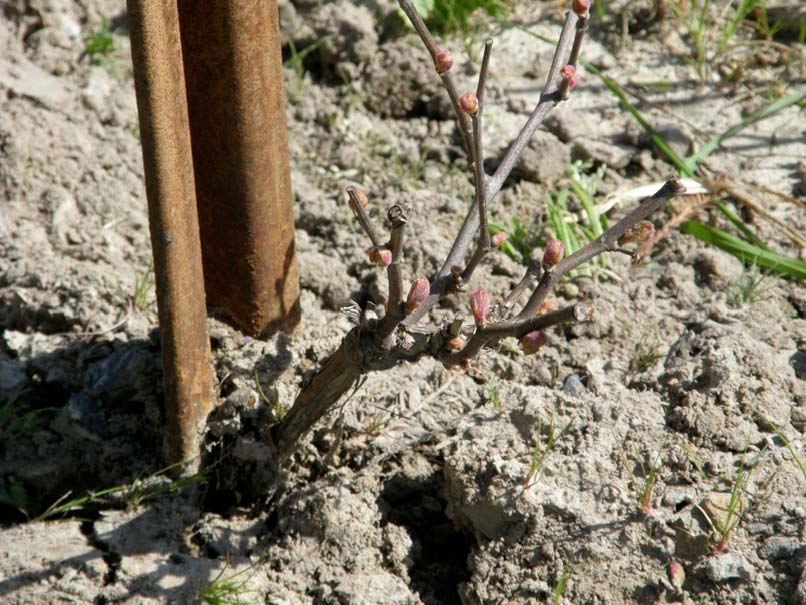Small Vines Wines: Pinot Noir Welcomes Close Company
Viticulturists speak of vine balance as the most important consideration in planting a vineyard. The term refers
to the balance between vine foliage or canopy and the number of clusters of fruit. The term can also be
invoked when speaking of the relative above ground growth in proportion to the vine’s root system. In either
case, it is the spacing of vines that plays a critical role in determining grape quality.
Vine spacing varies from 1 meter by 1 meter which is common in Burgundy and Champagne (about 4,000
vines per acre), to 8 feet by 12 feet or about 454 vines per acre which was the rule in California until the 1980s.
The traditional close plantings in Burgundy allowed maximal usage of the small amount of available land
making farming economically feasible. Also high density planting made sense because vineyards were
historically farmed by horses, vines were often lost from disease (high density planting made up for losses),
and the low vigor soils never allowed the vines to become large. The vine density in California was traditionally
chosen to accommodate the tractors and implements available at the time. Many of the vineyards were planted
on former apple orchards and the owners wanted to use the same tractors. Also, wider vine spacing was less
risky and allowed tailoring of the vine budding to the soil vigor. Crop thinning was necessary to reduce yields
and concentrate flavors. Over time, row spacing became narrower as newer, more compact farm equipment
was developed and hand farming for Pinot Noir became more in vogue. Many new vineyards were planted with
rows 6 feet wide and vines 4 feet apart for a total of 1,816 vines per acre. Initial plantings of Pinot Noir in the
1960s and 1070s in Oregon were often 5 feet by 10 feet or 6 feet by 8 feet (908 vines per acre). With the
arrival of Burgundian influence spearheaded by Domaine Drouhin and the availability of Dijon clones, Oregon
Pinot Noir vineyards planted to 1 meter by 2 meter spacing became more the norm and many California
plantings have followed suite.
The photos below illustrate the difference between traditional wide spaced plantings (the Olivet Lane Vineyard
planted in 1975 in the Russian River Valley, above) and close spaced plantings (the DuMol Vineyard planted in
2005 in Sebastopol, below).
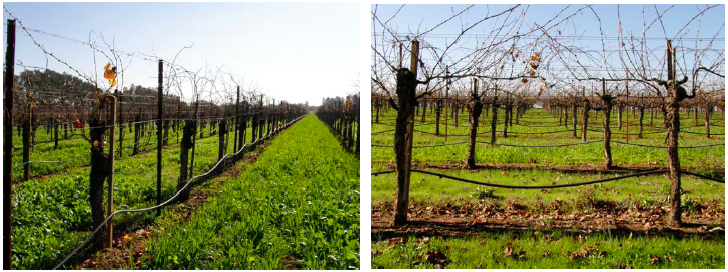
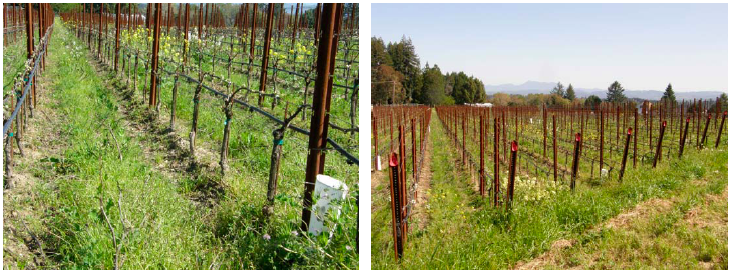
Inter row spacing (the distance between rows) is less critical for quality than within row spacing (the distance
between vines). Inter row spacing has minimal influence on vine balance so it makes sense to space rows
closely to achieve maximal yields from any given vineyard acreage. Within row spacing is more critical and can
also be tight, allowing increased yields without reducing quality because vines often do not compete with each
other. Mark Greenspan (“Vine Spacing: Is the Trend Toward High-Density Planting Going to End?”, published
in Wines & Vines, December 15, 2009) analyzed data of rooting density from several different vine density
plantings and found that root density continued to increase with vine density, even up to a density of 8,000
vines per acre. This tends to defuse the contention that vines compete with each other, although Greenspan
notes that there are likely soils where competition might be evident.
It is well known that great wines are produced from various types of vine layouts, but tight vine spacing
appears to have clear advantages with Pinot Noir. High density spacing is typically 4 feet by 4 feet to 4 feet by
2.5 feet. More vines per acre can be used to yield less fruit per vine. This spacing leads to better shading,
smaller vines that yield less fruit than a standard vine, and fruit that has the potential for increased quality. At
the same time, the amount of vines per acre is significantly increased, insuring that the vineyard retains
economic viability. Andy Humphrey, former Vineyard Manager for Archery Summit discussed close spacing in
an article titled “Yield Versus Quality,” by Jordan P. Ross (www.enologyinternational.com). He said, “Keeping
yields per vine low to achieve ripeness while increasing the number of vines per acre to attain economic yields
is what the French have known for many years. You can make excellent wine with 6 feet by 9 feet spacing, but
you have to get the yield per vine down so low that you can’t stay in business.” Tight spacing does come at a
cost, for it requires more vines to be planted, more labor, more attention, more irrigation lines, and specialized
farming equipment.
Viticulturists emphasize that yield per acre, usually expressed as tons per acre and often reported in the wine
press is not a badge of quality. Many wineries use yield per acre in their marketing promotional material which
is misleading to the consumer who often does not understand the true meaning of this indicator. Jordan P.
Ross points out that, “Yield per vine is a more accurate measure of quality because a lower yield per vine
means that each vine is better able to fully ripen a smaller crop load. With more vines per acre, yield per acre
goes up along with quality.”
Paul and Kathryn McGrath Sloan, inspired by a clear understanding of the advantages of close-spaced,
compact vines, launched Small Vines Viticulture (SVV) in Sonoma County in 1998. The name reflects the
simplicity of their underlying philosophy: smaller vines produce smaller and more intensely flavored grapes and
by extension higher quality wine. Close spacing maximizes vines per acre and minimizes pounds per vine.
This formula sustains profitability and increases quality which is critical when growing grapes aimed to sell at
100 times the bottle price of the wine.
SVV specializes in the planning, installation and precision viticulture of close-spaced estate Pinot Noir
vineyards in Sonoma County’s Russian River Valley and Sonoma Coast appellations. The viticulture company
is the only one in Sonoma County specializing solely in close spaced vineyard planting. The Sloans have
studied the differences in fog intrusion, temperature patterns, and rainfall between Burgundy and California,
adjusting their approach to high-density planting accordingly. For example, to accommodate California’s warmer climate, they use a unique fruiting height of between 24” and 32” that is much higher than in France,
where due to cooler temperatures the grapes sit right at ground level. Early attempts in California at high density
planting failed to adjust for the warmer soils and resulted in overripe or baked fruit qualities in the
wines. Raising the fruiting wire to address the radiant heat of California’s warmer soils while managing the
canopy for better balance between pH and acids, required extensive research and proved critical.
Paul Sloan is a third generation Sonoman who had his wine epiphany while working as a wine steward at
Sonoma County’s popular John Ash Restaurant, when he sampled his first Le Montrachet from Burgundy. His
passion was shared with then girlfriend and now spouse, Kathryn McGrath. Paul went on to win the prestigious
Greenwood Ridge California State Wine Tasting Competition with partner and winemaker Mat Gustafson. The
pair were considering a winery partnership but Mat pursued a career in winemaking and Paul devoted himself
full time to the study and practice of viticulture. While enrolled in the Santa Rosa Junior College viticulture
program, he went to work for legendary grape grower Warren Dutton of Dutton Ranch. Dutton encouraged
Paul to start his own close spaced winegrowing company despite the skepticism of others.
In 2004, SVV became the first viticultural company in America to import a specialized tractor specifically
tailored for high density viticulture. The Caval tractor, already in use in Europe and manufactured in France
was modified by Sloan to cultivate multiple rows at a time. The over-the-row function, multiple row capabilities,
and compact design made the new tractor the most cost effective close-spaced cultivar to come along in years.
At only 7 feet tall and 2,500 pounds, the CAVAL is road legal, and is gentle on vineyard soils and root systems.
Besides shoot positioning two rows at a time, mowing and seed drilling three rows at a time, and spraying up to
seven rows at a time, the CAVAL also performs hedging, leaf removal, French plowing, compost spreading and
fruit hauling. Sloan says, “The only thing it doesn’t do is harvest, and we prefer to do that by hand.” I saw the
tractor in action when I visited recently, weeding vine rows, two at a time, and it was very impressive. A
number of other pieces of specialized equipment have had to be designed and manufactured by SVV to
facilitate close spaced vine farming.
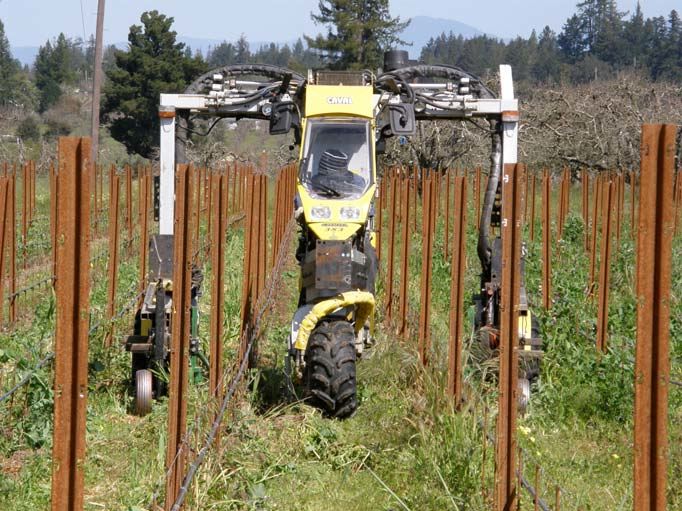
The Sloans work closely with several noted Sonoma County specialists including Daniel Roberts, PhD (“Dr.
Dirt” - Viticulturist), Alfred Cass (Soils Analyst), and Mike Bobbit (GPS, Weather Mapping Specialist).
Clients include Terry Adams, Paul Hobbs, Sonoma Coast Vineyards and Red Car Wines. In 2005, SVV
planted and farms the largest close-spaced vineyard (15 acres) in Sonoma County for DuMol Winery.
A second business model emerged beginning with the 2005 vintage, when the Sloans started Small Vines
Wines (SVW). They were already farming a number of vineyards to their specifications and had the
opportunity to lease back the MK Vineyard located above Occidental in the Sonoma Coast which SVV had
originally planted. With the availability of prime Pinot Noir fruit, they began producing small lots of ultrapremium
Pinot Noir. The wines were extremely well-received and the demand has resulted in the need to allocate their small production to release list members only. Paul crafts the wines currently in association with
noted winemaker consultant Byron Kosuge.
At this year’s World of Pinot Noir, while tasting over 50 Pinot Noirs in the Press Room, I became enraptured by
the 2007 Small Vines Russian River Valley Pinot Noir. This was clearly the best wine I sampled over a two day
period. I spoke with the Sloans and offered my congratulations. I visited them recently, spending time at three
of their vineyards, MK Vineyard, the DuMol Winery vineyard, and the Sloan’s estate vineyard, and tasting their
2007 and 2008 Pinot Noirs. Unfortunately, the 2007 vintage is sold out, but the equally impressive 2008 Small
Vines Pinot Noirs are available this spring. Happily, more wine was produced in the 2008 vintage.

2007 Small Vines Russian River Valley Pinot Noir
14.3% alc., pH
3.78, 277 cases, $50. 50% Baranoff Family Vineyard, 42% MK
Vineyard, 8% Old Mill Vineyard (all 6 to 8 year old vines). Organically
farmed 4 feet by 4 feet and 4 meter by 4 meter (2722-3350 vines per
acre). Yields 1.1-2.5 lbs. per vine. Clones: Dijon 113, 114, 115, 459,
667, 777, and Swan. Native yeast fermentation and MLF. Aged 15
months on fine lees in 50% new French oak. Unfined and unfiltered.
·
Moderately deep reddish-purple color in the glass. Impressively fruity nose
composed of spiced cherries and berries that is very pure and vivid. Delicious
core of red cherries, strawberries and raspberries, nicely spiced with accents of cola, caressing in the mouth
with a finish that sails along. A pretty and polished wine that is quintessential Russian River Valley Pinot Noir.
2007 Small Vines MK Vineyard Sonoma Coast Pinot Noir
14.3% alc., pH 3.68, 147 cases, $65.
Organically farmed. Clones: Dijon 114, 115, 667 and 777. Native yeast fermentation and MLF. Aged 15
months on fine lees in 66% new French oak, unfined and unfiltered. Tasted at the Sloan’s estate vineyard.
·
A
striking wine with a little more tannic backbone, more earthiness and darker fruits than the Russian River Valley
bottling. Lightly oaked, with a spicy and tenacious palate and great persistence.
The 2008 Small Vines Russian River Valley Pinot Noir and 2008 Small Vines MK Vineyard Pinot Noir follow in
the same path as the above wines. Tasted at the Sloan’s estate vineyard prerelease, they are equally
generous wines that are still youthful. They reflect their respective appellation terroirs beautifully, with the
Russian River Valley bottling more fruity and spicy and the Sonoma Coast bottling possessing more structural
bones, firmness and feral qualities. Both are very highly recommended. Photo below shows Paul, myself and
my pinotphile friend, Ed Buckley, sampling Small Vines Pinot Noirs in the Sloan’s “tasting room” under a
redwood grove with the Sloan’s estate vineyard visible in the background.
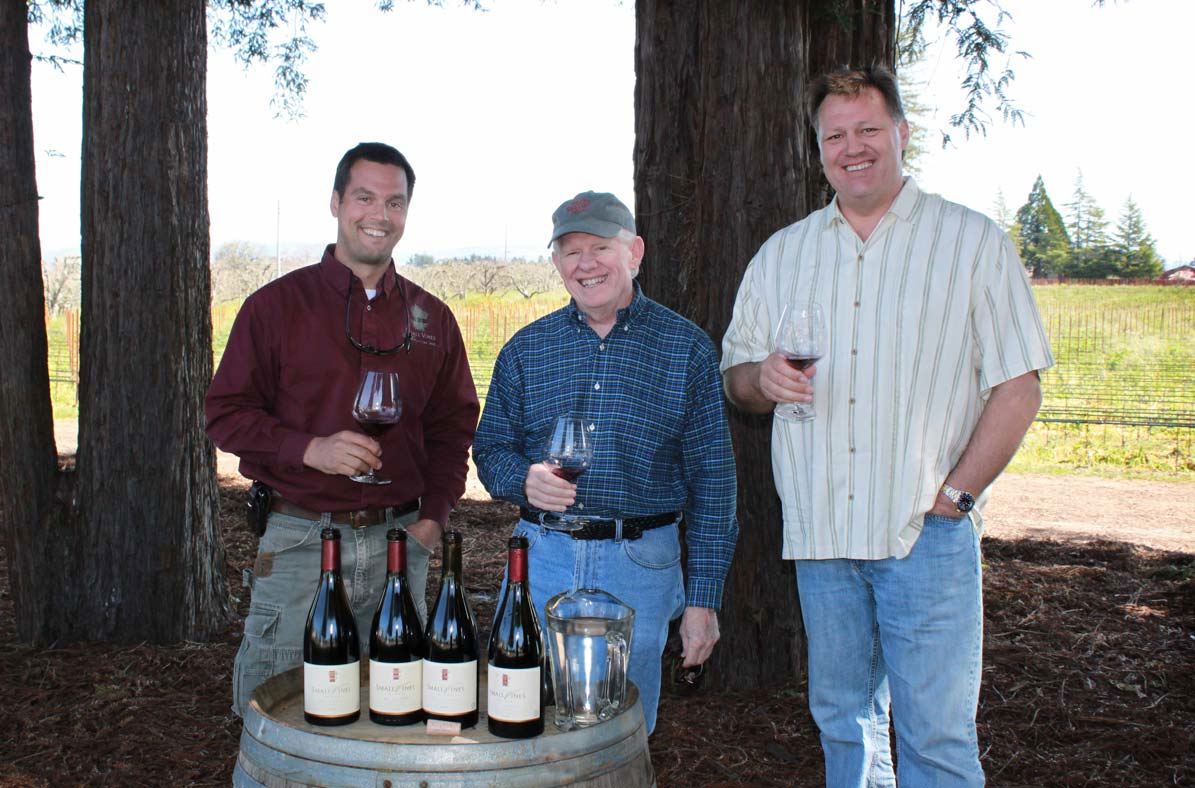
The Sloans are very passionate and innovative winegrowers who also craft extraordinary wines. I would
suggest you join their release list to guarantee access to future releases. The 2008 Small Vines Russian River
Valley Pinot Noir was just released, and the 2008 Small Vines MK Vineyard, with only 150 bottles available, will
be released in the fall primarily to mailing list members. Follow the informative Small Vines Blog and videos at
www.smallvines.com/blog. 2160 Green Hill Road, Sebastopol. 707-823-0886.
Bud break in mid-March in the Russian River Valley:








